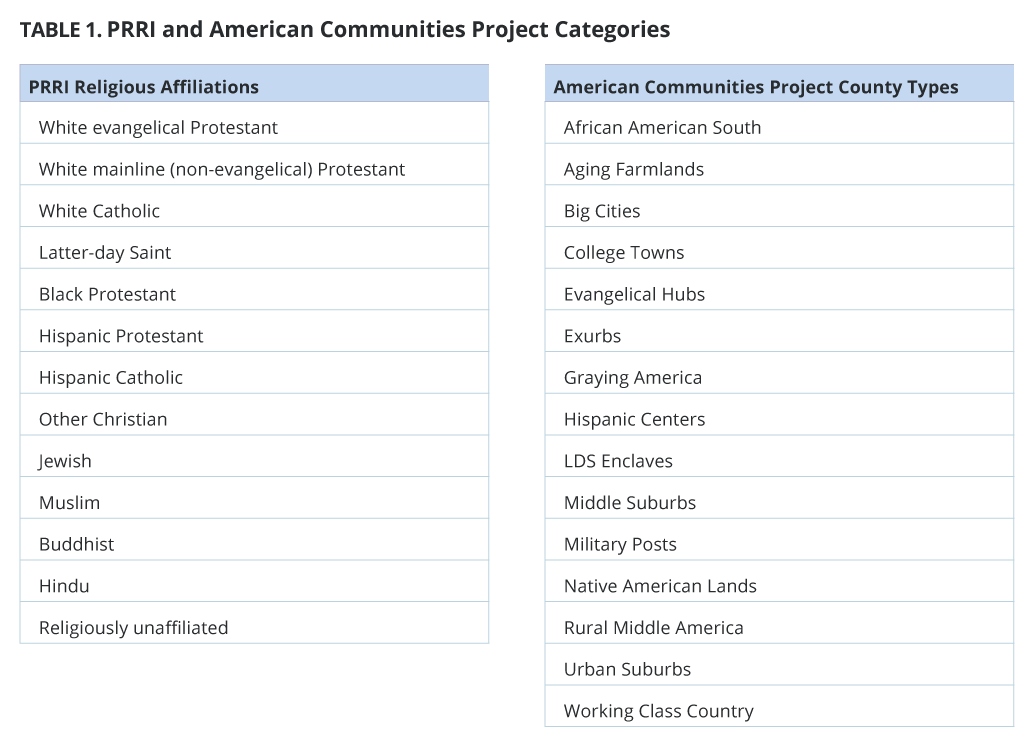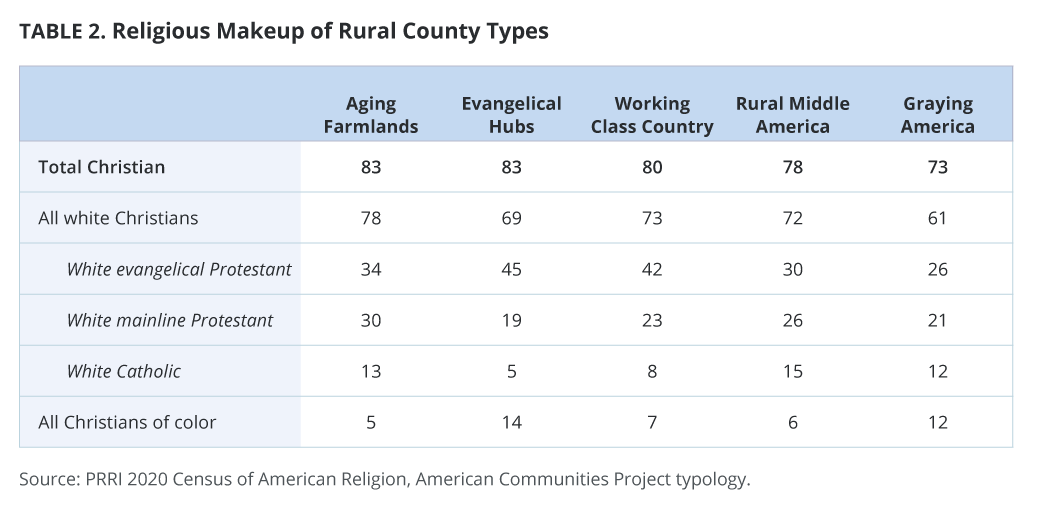The divide between rural and urban America has come to define American culture and politics in the 21st century. Urban areas are becoming increasingly Democratic, while rural areas are becoming increasingly Republican. However, the divides in experiences, cultures, and ways of life are not without an important dose of nuance.
Combining data from the Public Religion Research Institute’s 2020 Census of American Religion and the American Communities Project, we can further understand both the dynamics and the nuances of religious divisions between urban and rural America. PRRI’s county-level estimates of the sizes of major religious groups classified by the American Communities Project county typology reveals a patchwork of faith experiences that illuminates commonalities and differences across the urban-rural divide.
 Urban areas are often stereotyped as bastions of secularism, while rural areas are often portrayed as dominated by the traditional church. While these clichés may have grains of truth within them, there is significantly more nuance to the experiences of faith in rural and urban communities.
Urban areas are often stereotyped as bastions of secularism, while rural areas are often portrayed as dominated by the traditional church. While these clichés may have grains of truth within them, there is significantly more nuance to the experiences of faith in rural and urban communities.
Urban and Suburban Counties
Most residents of counties classified as Big Cities and Urban Suburbs claim a religious affiliation — 72% in Big Cities and 74% in Urban Suburbs – although their religious affiliations are among the most diverse in the country, and Christians make up a smaller portion of the faithful there than elsewhere. Around two-thirds of residents of these most densely populated counties claim a Christian affiliation (66% in Big Cities and 68% in Urban Suburbs), while six percent of residents of each of the county types claim a non-Christian affiliation. More than one-quarter of residents of Big Cities (28%) and Urban Suburbs (26%) are religiously unaffiliated.
In the Middle Suburbs counties, 76% of the population claims a religious affiliation. In the Exurbs counties, the figure is 78%. These counties are less densely populated and more racially and ethnically homogeneous, and are more likely than their Big Cities or Urban Suburbs counterparts to follow Christian faiths (75% in Middle Suburbs and 77% in Exurbs). Smaller numbers – roughly one to four percent – follow religions other than Christianity, and less than one in four residents of Middle Suburbs (24%) and Exurbs (22%) are religiously unaffiliated.
 Taking a deeper look at these communities shows some key contrasts: White Christian shares are larger in suburban and exurban areas, while Christians of color are more likely to live in urban areas. White Protestant groups are about half the size in Big Cities and Urban Suburbs (10% and 11% for white evangelical Protestants, 10% and 11% for white mainline Protestants, respectively) than they are in Exurbs or Middle Suburbs (28% and 23% for white evangelical Protestants, 20% and 20% for white mainline Protestants, respectively). Shares of white Catholics are smaller in Big Cities (10%) than in Urban Suburbs (16%), Exurbs (13%), and Middle Suburbs (20%). However, the opposite is true for Hispanic Catholics: 10% of residents of Big Cities are Hispanic Catholic, compared to eight percent of residents of Urban Suburbs, three percent of residents of Exurbs, and two percent of residents of Middle Suburbs. Larger shares of Black Protestants can be found in Big Cities (12%) and in Urban Suburbs (9%) than in Exurbs (5%) and Middle Suburbs (4%).
Taking a deeper look at these communities shows some key contrasts: White Christian shares are larger in suburban and exurban areas, while Christians of color are more likely to live in urban areas. White Protestant groups are about half the size in Big Cities and Urban Suburbs (10% and 11% for white evangelical Protestants, 10% and 11% for white mainline Protestants, respectively) than they are in Exurbs or Middle Suburbs (28% and 23% for white evangelical Protestants, 20% and 20% for white mainline Protestants, respectively). Shares of white Catholics are smaller in Big Cities (10%) than in Urban Suburbs (16%), Exurbs (13%), and Middle Suburbs (20%). However, the opposite is true for Hispanic Catholics: 10% of residents of Big Cities are Hispanic Catholic, compared to eight percent of residents of Urban Suburbs, three percent of residents of Exurbs, and two percent of residents of Middle Suburbs. Larger shares of Black Protestants can be found in Big Cities (12%) and in Urban Suburbs (9%) than in Exurbs (5%) and Middle Suburbs (4%).
Big Cities and Urban Suburbs are the only communities where shares of any individual non-Christian religious residents make up more than one percent of the population. In Big Cities, two percent of residents are Jewish, two percent are Muslim, one percent are Hindu, and one percent are Buddhist. In Urban Suburbs, three percent of residents are Jewish, while Muslims, Hindus, and Buddhists each make up one percent. One percent of residents of Exurbs and Middle Suburbs are Jewish, while less than half of one percent of residents are Muslims, Hindus, or Buddhists.
Rural and Working Class Country
Religion outside urban and suburban areas is dominated by Christian beliefs.
Around three-quarters or more residents are Christians, including 73% of Graying America, 78% of Rural Middle America, 80% of Working Class Country, 83% of Aging Farmlands, and 83% of Evangelical Hubs. White evangelical Protestants make up more than four in ten residents of Evangelical Hubs (45%) and Working Class Country, but their shares are smaller in Aging Farmlands (34%), Rural Middle America (30%), and Graying America (26%). White mainline Protestants make up around one-fifth to one-quarter of these communities, including 19% of Evangelical Hubs, 21% of Graying America, 23% of Working Class Country, 26% of Rural Middle America, and 30% of Aging Farmlands. Shares of white Catholics are larger in Rural Middle America (15%), Aging Farmlands (13%), and Graying America (12%) than in Working Class Country (8%) and Evangelical Hubs (5%).
While these five community types are mostly white, their geographies and incomes vary. Incomes are lower in Working Class Country counties, centered in Appalachia, and Evangelical Hubs counties, in Appalachia and throughout the South. Along with the African American South next door, these communities comprise the traditional “Bible Belt.” Despite their similarities, cultural tensions often surface as a result of racial and residential segregation.
The three other community types, all middle-income, dominate in the Midwest and the West. Aging Farmlands counties are gathered in the Great Plains. Rural Middle America fills 599 counties in the country’s upper half, from Maine to Montana to Washington. Graying America counties fill the West and are also scattered across the Great Lakes region, the far Northeast, and Florida.
Groups of Christians of color are extremely small in these communities. Less than one in ten residents of Evangelical Hubs are Black Protestants (6%), while four percent of residents of Graying America are Hispanic Catholics and two percent are Hispanic Protestants. Other than these small shares, Hispanic Protestants, Hispanic Catholics, and Black Protestants make up one percent or less of the population of these communities. Residents who follow non-Christian religions make up less than half of one percent of these rural and working-class communities.
Interestingly, around one-quarter of residents of Graying America are religiously unaffiliated, compared to smaller shares of Rural Middle America (22%), Working Class Country (20%), Evangelical Hubs (17%), and Aging Farmlands (17%).
Race and Faith Experiences Outside the Cities
Aside from Big Cities and Urban Suburbs, the only other communities where less than half of residents are white Christians are Hispanic Centers, Native American Lands, and the African American South.
Around one-quarter of residents of Hispanic Centers are Hispanic Catholics (27%), while an additional nine percent are Hispanic Protestants. Even in Hispanic Centers, there are still significant shares of white evangelical Protestants (21%) and white mainline Protestants (12%). Residents of Hispanic Centers are some of the least likely to be religiously unaffiliated (17%).
In Native American Lands, 30% of residents are Other Christians, the category of Christians that includes Native Americans, while about one-third as many are white evangelical Protestants (11%), white mainline Protestants (11%), or white Catholics (8%). Interestingly, Native American Lands include the largest shares of religiously unaffiliated Americans (32%) of any community type.
In the African American South, counties concentrated from Virginia to Texas with a median 37% Black population, nearly three in ten residents are Black Protestants (28%), while a similar share are white evangelical Protestants, 13% are white mainline Protestants, and five percent are white Catholics. Different church denominations dot the landscape. In daily life, Blacks and whites tend to segregate, including at church, but in some communities it’s common for Blacks and whites to come together to worship on holidays, including Easter and Thanksgiving. Just 14% are religiously unaffiliated, the smallest share of any community type. With the large share of Black Protestants and white Evangelical Protestants, the African American South has the largest share of Christians of all community types (84%).
Unique Community Types
Three community types have notably different religious patterns from the other community types: Military Posts, College Towns, and LDS Enclaves.
Military Posts counties are often more religiously diverse than the surrounding counties. One-quarter of residents are white evangelical Protestants, while 17% are white mainline Protestants and nine percent are white Catholics. Black Protestants make up nine percent of the population, other Christians make up eight percent, Hispanic Catholics make up three percent, and two percent are Hispanic Protestants. Around one-quarter of residents are religiously unaffiliated (24%).
College Towns counties are also more diverse and less white Christian than surrounding counties: 23% are white evangelical Protestants, 20% are white mainline Protestants, and 12% are white Catholics. Small percentages are Christians of color: Black Protestants (4%), Hispanic Protestants (2%), and Hispanic Catholics (2%). College Towns are the only communities outside urban or suburban types where one percent of residents are either Jewish, Buddhist, or Hindu. More than one-quarter of residents are religiously unaffiliated (28%).
Finally, and unsurprisingly, LDS Enclaves counties are predominantly made up of Latter-Day Saints (46%). Around one in ten residents are white mainline Protestants (11%), white evangelical Protestants (10%), or white Catholics (6%). Christians of color make up small shares of the population here: Three percent are Hispanic Catholic, two percent are other Christians, and one percent are Hispanic Protestants. No other religious groups exceed half of one percent, and 21% are religiously unaffiliated.




